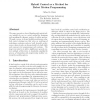Free Online Productivity Tools
i2Speak
i2Symbol
i2OCR
iTex2Img
iWeb2Print
iWeb2Shot
i2Type
iPdf2Split
iPdf2Merge
i2Bopomofo
i2Arabic
i2Style
i2Image
i2PDF
iLatex2Rtf
Sci2ools
ICRA
1998
IEEE
1998
IEEE
Hybrid Control as a Method for Robot Motion Programming
This paper presents a class of fundamental control policies suitable for use in a novel method for designing and specifying the dynamic motion of robotic systems. Through recourse to formal stability mechanisms a hybrid control strategy one that relies on switching of underlying continious policies with desirable performance characteristics is demonstrated to be both stable and expressive for programming such motions. The long term intent is to utilize slightly more general control methods of this form to drastically simplify the process of integrating and programming modular automated assembly systems.
Desirable Performance Characteristics | Fundamental Control Policies | Hybrid Control Strategy | ICRA 1998 | Robotics |
Related Content
| Added | 04 Aug 2010 |
| Updated | 04 Aug 2010 |
| Type | Conference |
| Year | 1998 |
| Where | ICRA |
| Authors | Alfred A. Rizzi |
Comments (0)

